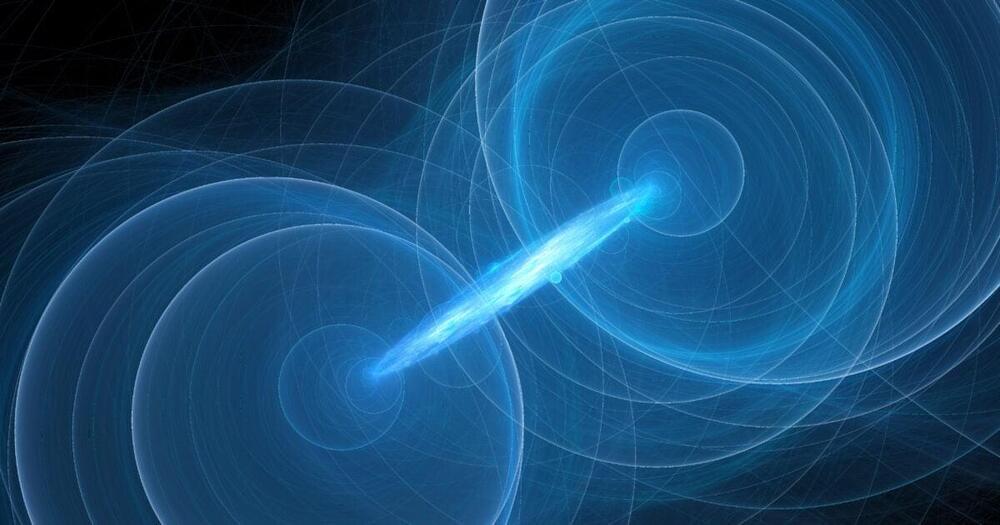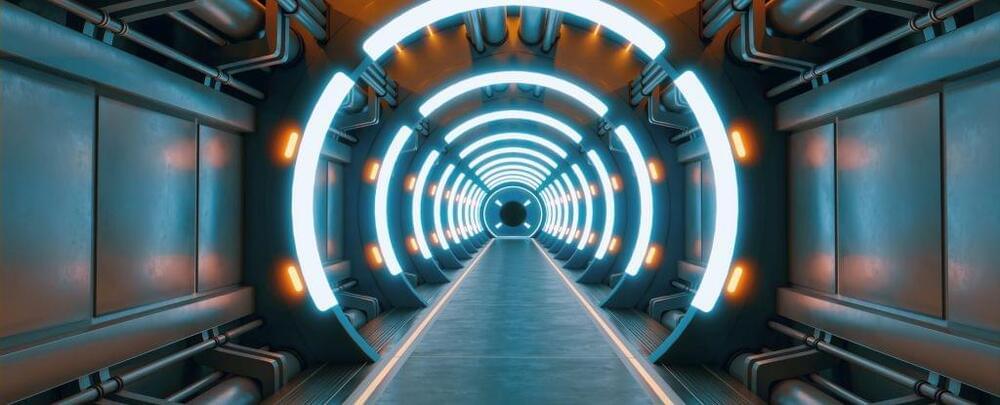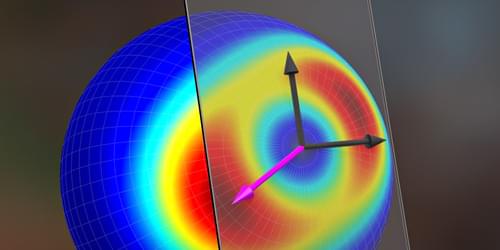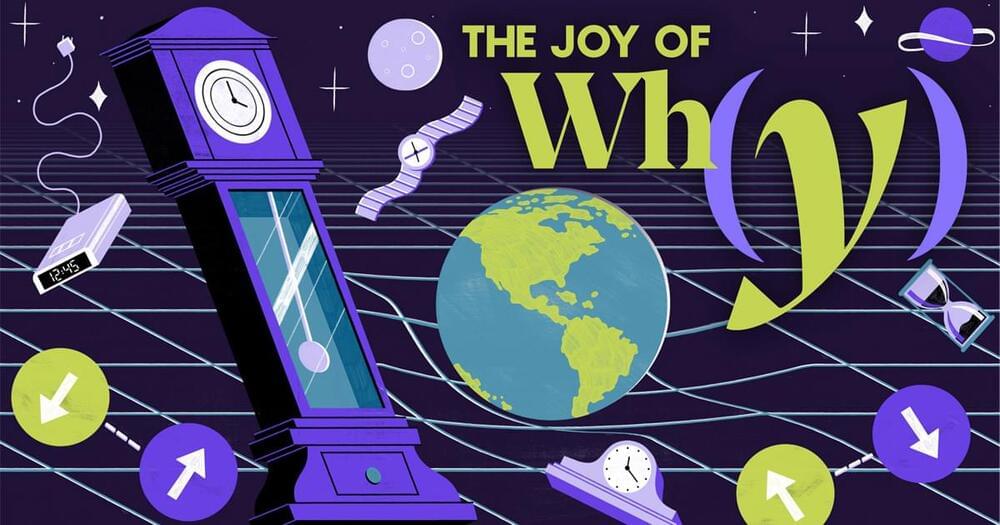Date October 11, 2023



Hindsight, as they say, is 20/20, but sometimes it would be nice to have known the outcomes before making a choice. This is as true in day-to-day life as it is in quantum mechanics. But it seems that the quantum world has something we do not have: a way to alter yesterday’s choices today, before they become tomorrow’s mistakes.
None of this is real time-travel. Physicists remain skeptical about that possibility. However, it is possible to simulate a closed time-loop with quantum mechanics, thanks to the property of entanglement. When two particles are entangled, they are in a single state even if they are separated by huge distances. A change to one is a change to the other, and this happens instantaneously.
So a particle can be prepared for an experiment, entangled, and sent to the experiment. Then scientists can modify its entangled companion, changing the way the particle in the experiment behaves.

#spacetravel #quantumvacuum IRIS-AsteronX & The Eos Project.
Website: www.asteronx.com Links to research papers: Shinichi Seike, 1969, “Quantum Electric Space Vehicle”, 8th Symposium on Space Technology and Science, Tokyo. Froning, H. D., “Propulsion Requirements for a Quantum Interstellar Ramjet”, Journal of the British Interplanetary Society, vol. 33, p. 265, 1980.Froning, H. D., “Investigation of a quantum ramjet for interstellar flight” (AIAA Preprint 81–1534, 1981).Robert L. Forward, Extracting Electrical Energy From the Vacuum by Cohesion of Charged Foliated Conductors, Physical Review B, Vol. 30, pp. 1700–1702 (1984).“Casimir-cavity-induced conductance changes,” G. Moddel, A. Weerakkody, D. Doroski, D. Bartusiak, Physical Review Research, 3, L022007 (2021); DOI: 10.1103/PhysRevResearch.3.L022007.Garret Moddel: Zero-Point Energy Technology.
https://www.colorado.edu/faculty/moddel/research/zero-point-…gyJennifer Chu, “Quantum fluctuations can jiggle objects on the human scale”, MIT News Office, 2020.Dr Gregory L. Matloff, The Zero-Point Energy (ZPE) Laser and Interstellar Travel, Academia.edu, posted by Adam Crowl.
https://www.academia.edu/Ivlev, B.I… (2016). Conversion of zero point energy into high-energy photons. Revista mexicana de física, 62, 83–88. Recuperado en 18 de junio de 2022, de http://www.scielo.org.mx/.X. Jiang, X. Zhou and W. Peng, “Extraction of clean and cheap energy from vacuum,” 2013 International Conference on Materials for Renewable Energy and Environment, 2013, pp. 467–471, https://doi.org/10.1109/.H. David Froning, Morgan Boardman, Less Labored Acceleration and Faster-than-Light Travel in Higher Dimensional Realms, published in Faster Than Light Warp Drive and Quantum Vacuum Power by H. David Froning. Physicists are planning to build lasers so powerful they could rip apart empty space.
https://www.science.org/Terrance W. Barrett. The toroid antenna as a conditioner of electromagnetic fields into (low energy) gauge fields. Speculations in Science and Technology 21291–320 (1999). Originally presented at the Progress in Electromagnetics Research Symposium 1998, (PIERC’ 98), 13th-17th July, Nantes France. Daniel C. Cole and Harold E. Puthoff, Extracting energy and heat from the vacuum, Physical Review, Vol E48, #2, pp. 1562–1565 (August 1993).Harold White. Paul March. Advanced Propulsion Physics: Harnessing the Quantum Vacuum. (2011). https://www.lpi.usra.edu/meetings/nets2012/pdf/3082.pdfFong, K.Y., Li, HK., Zhao, R. et al. Phonon heat transfer across a vacuum through quantum fluctuations. Nature 576243–247 (2019). https://doi.org/10.1038/s41586-019-1800-4Music: Songs from the YouTube audio library.
https://studio.youtube.com/channel/UC2kkCGRqZWaSIK3BmLC8vaw/music(Natural Light) by Chris Haugen.
(Mind Stream) by Chris HaugenYouTube Audio Library License.
You can use this audio track in any of your videos, including videos that you monetize. No attribution is required. YouTube may credit the artist and link the Audio Library from your video.
You may not make available, distribute or perform the music files from this.
library separately from videos and other content into which you have incorporated.
these music files (e.g., standalone distribution of these files is not permitted).Free music by Scott Buckley.
https://www.scottbuckley.com.au/(What we don’t say) by Scott Buckley.
(Soar) by Scott Buckley.
released under CC-BY 4.0
www.scottbuckley.com.au https://www.scottbuckley.com.au/
https://www.scottbuckley.com.au/library/
https://www.youtube.com/channel/UC1GClXNsp99r4rvthPRwBLAPurchased
From Bandcamp.com.
Big Giant Circles — Legacy — 9 Nova Siberia OC ReMix-bonus-.mp3
Big Giant Circles — Legacy — 3 Faster Than Light-unused-.mp3
Big Giant Circles — Legacy — 6 Hold the Line-unused-.mp3
Big Giant Circles — Legacy — 9 Nova Siberia OC ReMix-bonus-.mp3 Purchased from Shockwave-sound.com.
Music Space Command (24-bit).wavPurchased from Pond5.com.
010892636-revelation.mp3 Purchased from NCM Epic Music Ender Guney.
Epic Cinematic Music.wavMusic from Kevin MacLeod.
Journeyman.mp3
Mystery Sax.mp3
Hungarian_Rhapsody_No_2_by_Liszt.mp3
https://incompetech.com/music/royalty-free/licenses/
https://creativecommons.org/Purchased from purple planet.
shadowlands.mp3 Copyright free music by WC Music.
life with you — Music by (Barradeen) _ WC Music (No Copyright Music)_1080p.mp4

For most of us, the passage of time flies in just one inexorable direction.
But for theoretical quantum physicists, time’s direction isn’t quite so inflexible. It’s possible to theoretically model, simulate, and observe the backwards flow of time in ways that are impossible to achieve in the real world.
And now, scientists have shown that simulations of backwards time travel can help solve physics problems that cannot be resolved with normal physics.

A new method identifies the most sensitive measurement that can be performed using a given quantum state, knowledge key for designing improved quantum sensors.
A quantum sensor is a device that can leverage quantum behaviors, such as quantum entanglement, coherence, and superposition, to enhance the measurement capabilities of a classical detector [1–5]. For example, the LIGO gravitational-wave detector employs entangled states of light to improve the distance-measurement capabilities of its interferometer arms, allowing the detection of distance changes 10,000 times smaller than the width of a proton. Typically, quantum sensors use systems prepared in special quantum states known as probe states. Finding the ideal probe state for a given measurement is a focus of many research endeavors. Now Jarrod Reilly of the University of Colorado Boulder and his colleagues have developed a new framework for optimizing this search [6].

“The surprising thing we found is that in a particular kind of crystal lattice, where electrons become stuck, the strongly coupled behavior of electrons in d atomic orbitals actually act like the f orbital systems of some heavy fermions,” said Qimiao Si, co-author of a study about the research in Science Advances
<em> Science Advances </em> is a peer-reviewed, open-access scientific journal that is published by the American Association for the Advancement of Science (AAAS). It was launched in 2015 and covers a wide range of topics in the natural sciences, including biology, chemistry, earth and environmental sciences, materials science, and physics.

Oh boy. What could go wrong?
Scientists trying to take advantage of the unusual properties of the quantum realm say they have successfully simulated a method of backward time travel that allowed them to change an event after the fact one out of four times. The Cambridge University team is quick to caution that they have built a time machine, per se, but also note how their process doesn’t violate physics while changing past events after they have happened.
“Imagine that you want to send a gift to someone: you need to send it on day one to make sure it arrives on day three,” explained lead author David Arvidsson-Shukur from the Cambridge Hitachi Laboratory. “However, you only receive that person’s wish list on day two.”
To respect the gift recipient’s timeline, you would need to send it on day one. But, as Arvidsson-Shukur notes, you won’t know what gift to send until later, meaning your gift will either be late or be wrong.
Get a Wonderful Person Tee: https://teespring.com/stores/whatdamath.
More cool designs are on Amazon: https://amzn.to/3wDGy2i.
Alternatively, PayPal donations can be sent here: http://paypal.me/whatdamath.
Hello and welcome! My name is Anton and in this video, we will talk about an invention of a DNA bio computer.
Links:
https://www.nature.com/articles/s41586-023-06484-9
https://www.washington.edu/news/2016/04/07/uw-team-stores-di…perfectly/
Other videos:
https://youtu.be/x3jiY8rZAZs.
https://youtu.be/JGWbVENukKc.
#dna #biocomputer #genetics.
0:00 Quantum computer hype.
0:50 Biocomputers?
1:55 Original DNA computers from decades ago.
3:10 Problems with this idea.
3:50 New advances.
5:35 First breakthrough — DNA circuit.
7:30 Huge potential…maybe.
Support this channel on Patreon to help me make this a full time job:
https://www.patreon.com/whatdamath.
Bitcoin/Ethereum to spare? Donate them here to help this channel grow!
bc1qnkl3nk0zt7w0xzrgur9pnkcduj7a3xxllcn7d4
or ETH: 0x60f088B10b03115405d313f964BeA93eF0Bd3DbF
Space Engine is available for free here: http://spaceengine.org.

And that’s where the trouble really starts. Down there, nature is governed by quantum mechanics. This amazingly powerful theory has been shown to account for all the forces of nature, except gravity. When physicists try to apply quantum theory to gravity, they find that space and time become almost unrecognizable. They seem to start fluctuating wildly. It’s almost like space and time fall apart. Their smoothness breaks down completely, and that’s totally incompatible with the picture in Einstein’s theory.
(01:54) As physicists try to make sense of all of this, some of them are coming to the conclusion that space and time may not be as fundamental as we always imagined. They’re starting to seem more like byproducts of something even deeper, something unfamiliar and quantum mechanical. But what could that something be? Joining me now to discuss all this is Sean Carroll, a theoretical physicist who hosts his own podcast, Mindscape. Sean spent years as a research professor of physics at Caltech [California Institute of Technology], but he is now moving to Johns Hopkins as the Homewood Professor of Natural Philosophy. He’s also an external professor at the Santa Fe Institute. But no matter where he is, Sean studies deep questions about quantum mechanics, gravity, time and cosmology. He’s the author of several books, including his most recent, Something Deeply Hidden: Quantum Worlds and the Emergence of Spacetime. Sean, thank you so much for joining us today.